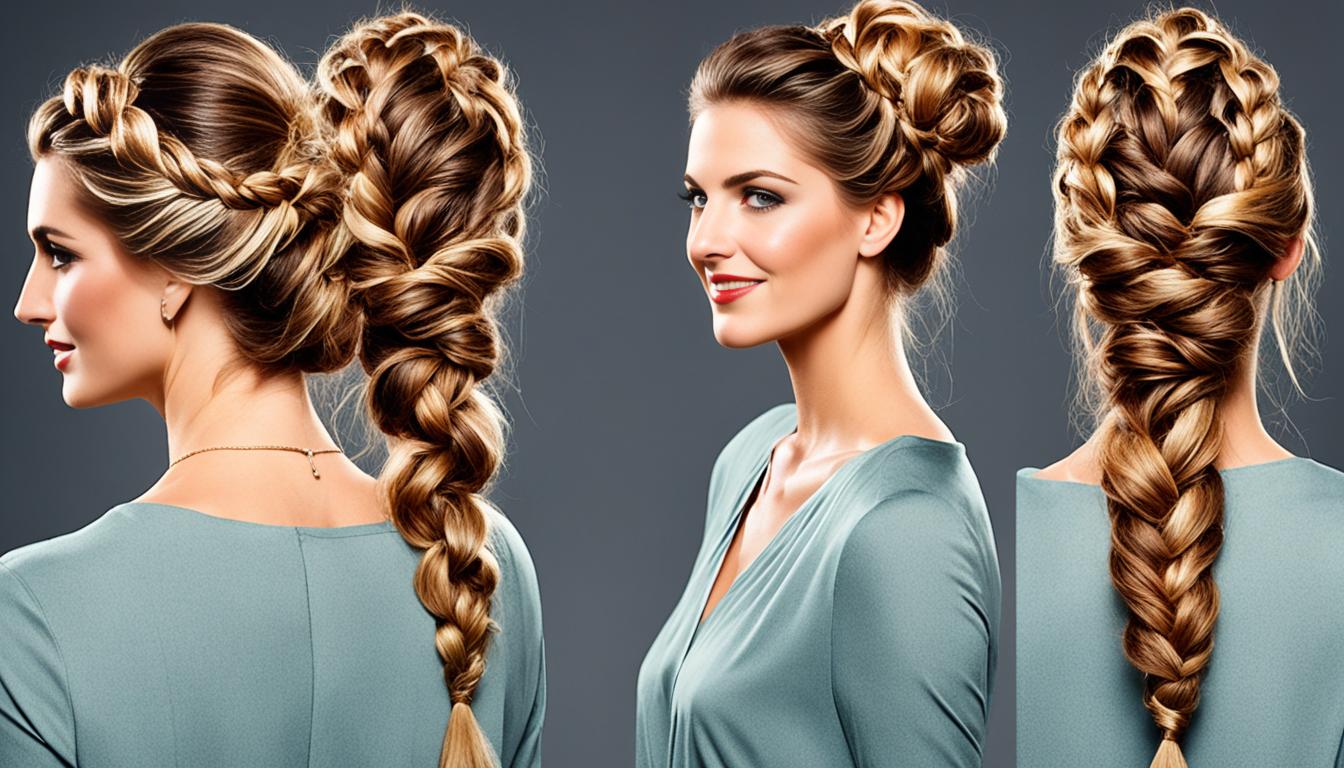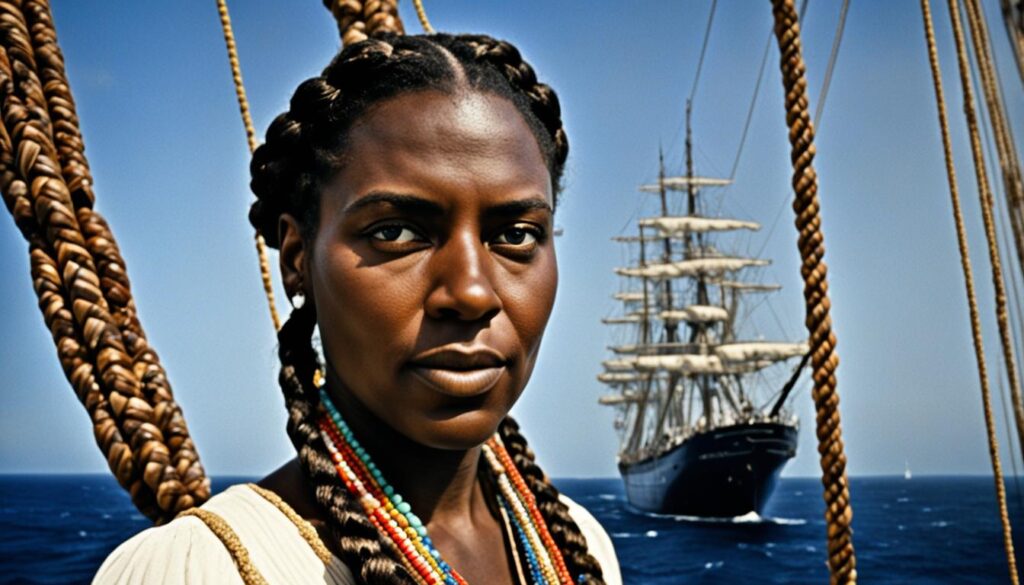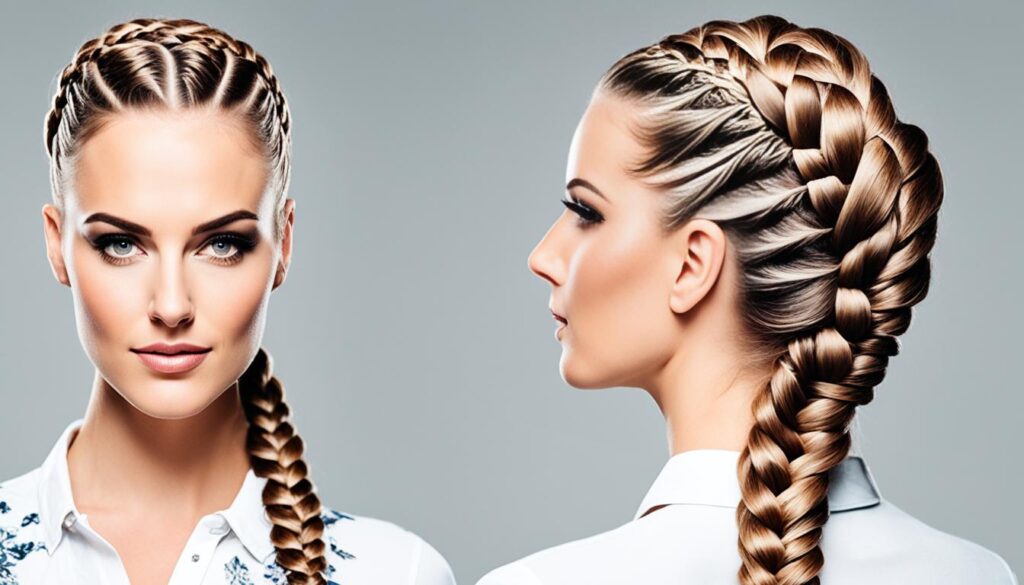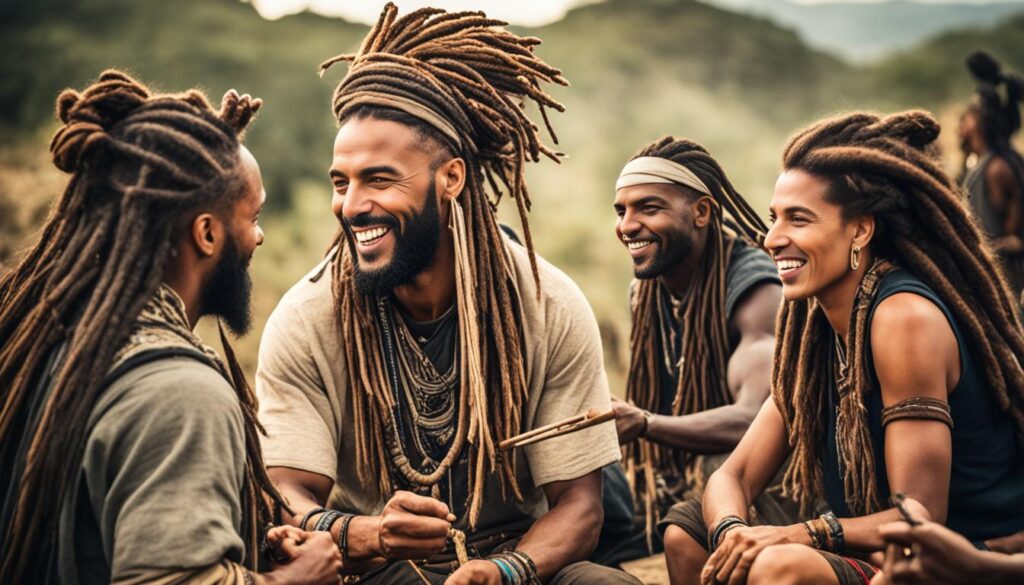
When you think of traditional Italian hairstyles, what comes to mind? Flowing curls? Elaborate updos? Believe it or not, braids have played a significant role in Italian hair fashion throughout history. Contrary to popular belief, Italians did indeed have braids as part of their cultural hair traditions.
When looking at images of 14th-century Italian hairstyles, it is clear that braided and wrapped styles were prevalent. These hairstyles were often held in place with hairpins or sewing, showcasing the skill and creativity of Italian braiding techniques. From intricate braided styles to wrapped braids around the head, the use of braids in Italian culture was a notable part of their hair fashion.
So why don’t we hear more about Italian braided hairstyles? In this article, we’ll delve into the rich history of Italian hairstyles, explore the significance of braids in Italian culture, and discover the ancient Italian braids that were once the height of fashion. Get ready to uncover a fascinating side of Italian hair traditions and challenge some common beliefs along the way.
Key Takeaways:
- Italian hairstyles have included braids throughout history, challenging common beliefs.
- Braided and wrapped styles were prevalent in 14th-century Italian hairstyles.
- Braids were held in place with hairpins or sewing and showcased the skill of Italian braiding techniques.
- Italian braided hairstyles have a rich cultural significance that is often overlooked.
- Exploring the ancient Italian braids can provide valuable insights into Italian hair fashion.
The Origin of Braids and Braided Hairstyles
The origin of braids can be traced back over 30,000 years to the ancient African cultures. This rich history is evident in the cave paintings found in the Saharan desert, depicting women adorned with intricate braids known as cornrows. These braided hairstyles served as a means of expressing various aspects of an individual’s identity, including age, religious beliefs, family lineage, societal status, and ethnicity.
Braids held significant cultural relevance and were passed down through generations, serving as a form of cultural preservation. They were not merely hairstyles, but powerful symbols of heritage and tradition.
While braids originated in ancient Africa, they have also been observed in various cultures around the world, highlighting the global history of braided hairstyles. The practice of braiding hair transcends geographical boundaries and has become a universal form of self-expression and identity. Whether it’s the braided hairstyles of Native American tribes, the intricate patterns of Celtic cultures, or the artistic cornrows in African-American communities, braids continue to hold immense cultural significance.
Take a closer look at some notable braided hairstyles from different cultures:
- African Cornrows: An iconic braided hairstyle characterized by rows of neatly woven braids close to the scalp, with intricate patterns and designs.
- Viking Braids: Braids were commonly worn by Vikings, both men and women, and were often intertwined with beads, feathers, or other decorative elements.
- French Braids: Also known as “plaits,” French braids are created by weaving three sections of hair together, resulting in an elegant and timeless look.
- Inuit Braids: Inuit braids, also known as “Eskimo” or “Inuk Buns,” feature two braided sections of hair wrapped around the head, resembling a crown.
- Maasai Braids: The Maasai people of East Africa are known for their vibrant and long braids, adorned with beads and cowrie shells.
Braids are not just hairstyles; they are a form of identity expression, artistic creativity, and cultural heritage. Their beauty and significance continue to inspire and captivate people of all backgrounds.
“Braids are not just hairstyles; they are a form of identity expression, artistic creativity, and cultural heritage.”
Braids and the Impact of Colonization and Slavery
During the era of colonization and trans-Atlantic slavery, braids played a crucial role in preserving the identity and culture of people of color. As a form of resistance against the stripping of their identities, enslaved individuals often braided their hair as a way to communicate important messages and maintain their cultural heritage.
Braided hairstyles became a practical way to keep hair manageable during labor and could last for extended periods of time without constant care. The durability and versatility of braids allowed enslaved individuals to navigate the harsh conditions of their lives while also preserving their cultural traditions.
Braids served as a lifeline for many in the pursuit of freedom. They provided routes for hiding seeds and tools necessary for survival during escape attempts. Additionally, certain braided patterns were used as maps, guiding individuals on their journey to liberation.
Braids were not only practical but also symbolic. They represented defiance against forced assimilation and a declaration of cultural identity. By keeping their hair braided, people of color were able to assert their individuality and maintain a connection to their African roots.
The Role of Braids in Identity Preservation
For enslaved individuals, braids served as a powerful tool in preserving their cultural identity. By continuing to wear braided hairstyles, they were able to resist the erasure of their heritage and assert their unique cultural background.
Braids became a poignant symbol of resilience and unity amongst the enslaved population. The act of braiding each other’s hair created a sense of community and solidarity. It allowed individuals to come together, share their experiences, and find solace in their shared struggles.
By braiding their hair, enslaved individuals were able to reclaim a sense of agency in a system that sought to dehumanize and oppress them. Braids became a physical manifestation of resistance and a source of empowerment during times of unimaginable hardship.
“Braids were not just a hairstyle, they were a lifeline for our ancestors. They carried our stories, our strength, and our hope for a better future.”
The Evolution of Braids in Modern Culture
Today, braided hairstyles continue to be a powerful form of self-expression. They have evolved into modern cultural practices, transcending the boundaries of race and ethnicity. Braids are now appreciated and worn by individuals from diverse backgrounds as a nod to their beauty and versatility.
The popularity of braided hairstyles extends beyond practicality. People embrace braids as a way to celebrate and pay homage to the rich history and cultural significance associated with these hairstyles. However, it is essential to approach the adoption of braided hairstyles with respect and an understanding of their cultural roots.
Braids serve as a reminder of the resilience and strength of those who came before us. They carry the stories of our ancestors and provide a connection to our collective history. By wearing braids, we honor their legacy and contribute to the ongoing preservation of cultural traditions.

| Braids and Colonization | Braids during Trans-Atlantic Slavery | Role of Braids in Identity Preservation |
|---|---|---|
| Braids served as a symbol of resistance against colonization and forced assimilation. | Enslaved individuals used braided hairstyles to preserve their cultural identity and resist the dehumanizing effects of slavery. | Braids allowed individuals to assert their unique cultural background and maintain a connection to their African roots. |
| Braids represented a form of defiance, asserting individuality and cultural pride. | Braids were practical for managing hair during labor and provided routes for hiding important tools and seeds during escape attempts. | Braiding each other’s hair fostered community and unity amongst the enslaved population, creating a sense of resilience and solidarity. |
| Braids became a lifeline for many in the pursuit of freedom, with certain braided patterns serving as maps for escape routes. | Through braided hairstyles, enslaved individuals reclaimed agency and empowerment in the face of oppression. | Braids continue to be a powerful form of self-expression and a way to honor the resilience and strength of our ancestors. |
The Evolution of Braids in Modern Culture
Braided hairstyles have become a popular choice in modern culture, offering both practicality and versatility. These modern braided styles not only help maintain hair length, volume, and integrity but also serve as a form of self-expression. With a wide range of options available, individuals can choose from various modern braided hairstyles that suit their preferences and personal style.
One popular modern braided hairstyle is cornrows. Cornrows are narrow, symmetrical braids that are close to the scalp. They can be styled in different patterns, creating intricate and eye-catching designs. Cornrows are not only fashionable but also provide excellent protection for the hair, as they keep it neatly tucked away, reducing the risk of damage and promoting healthy growth.
Another classic braided hairstyle is box braids. Box braids are individual plaits created by sectioning the hair into small square or rectangular sections and braiding synthetic or natural hair extensions into each section. This style offers versatility, allowing individuals to experiment with different lengths, thicknesses, and colors. Box braids are low-maintenance and can last for several weeks, making them a practical choice for those with busy lifestyles.
If you’re looking for a carefree and bohemian look, bohemian box braids are a popular choice. These braids are typically larger than traditional box braids and have a slightly undone appearance. Bohemian box braids exude a relaxed and effortless vibe, perfect for those who want to embrace their free-spirited side.
Passion twists are another modern braided hairstyle that has gained popularity in recent years. These twists are created using a specialized hair extension technique that mimics the appearance of natural curls. Passion twists offer a unique blend of braids and twists, adding texture and dimension to the hair. They are a great option for individuals who want a fun and glamorous style.
Fulani braids, inspired by the Fulani people of West Africa, have also become a trendy option. These braids feature a central cornrow or braid, often adorned with beads or other accessories, while the rest of the hair is left loose or braided in a different style. Fulani braids celebrate African culture and offer a stylish yet culturally significant look.

It’s important to acknowledge and address the issue of cultural appropriation when it comes to braided hairstyles. While braids have deep roots in African culture and history, they have been adopted and popularized by mainstream culture without always recognizing their cultural significance. It is crucial to educate ourselves and appreciate the origins of these styles, avoiding appropriating hairstyles that hold deep cultural and historical importance to marginalized communities.
The Practicality of Braids
Braided hairstyles offer practical benefits that make them a go-to option for many individuals. Here are some of the practical advantages of braids:
- Braids can protect the hair from daily wear and tear, reducing breakage and promoting hair health.
- They require minimal maintenance, making them a time-saving option for those with busy schedules.
- Braids can maintain natural hair moisture by minimizing exposure to harsh environmental factors.
- They can be versatile and easily customizable, allowing individuals to experiment with different styles and looks.
| Advantages of Braids | Explanation |
|---|---|
| Protection | Braids offer protection for the hair, reducing breakage and damage. |
| Low Maintenance | Braids require minimal maintenance, saving time and effort. |
| Moisture Retention | Braids help retain moisture in the hair, reducing dryness and preventing damage. |
| Versatility | Braids can be styled in various ways, allowing individuals to experiment with different looks. |
Braided hairstyles have stood the test of time and continue to evolve in modern culture. They offer not only practical benefits but also allow individuals to express their unique style. However, it is crucial to appreciate and respect the cultural significance of braids while embracing their beauty and versatility. By acknowledging the origins and cultural importance of braided hairstyles, we can celebrate diversity and foster a more inclusive and respectful society.
The Fascinating History of Dreadlocks
Dreadlocks, also known as “nature’s braids,” have a long history rooted in various cultures and traditions. The origin of the term “dreadlocks” is debated, but the locking of hair has been a global phenomenon for centuries.
“Dreadlocks are about embracing your natural beauty and celebrating the unique journey of your hair.”
Ancient Egyptian mummies have been discovered with dreadlocks still intact, and ancient pharaohs were depicted with dreadlocks in tomb carvings and drawings.
Dreadlocks have been worn by Romans, Vikings, Germanic tribes, monks in the Ethiopian Orthodox Church, Sadhus of Hinduism, and early Christians, among others. The significance and symbolism of dreadlocks vary across different traditions and belief systems.
Table: Historical Depictions of Dreadlocks in Various Cultures and Traditions
| Culture/Tradition | Significance/Symbolism |
|---|---|
| Ancient Egyptians | Symbolized spiritual and divine connection |
| Rastafarianism | Represented a rejection of Western ideals and a connection to African roots |
| Viking/Norse | Indicated a warrior’s status, strength, and fearlessness |
| Monks in the Ethiopian Orthodox Church | Symbolized a vow of asceticism and dedication to religious beliefs |
| Hinduism (Sadhus) | Signified renunciation of worldly attachments |
| Early Christians | Represented a humble and simple lifestyle |
Whether it’s a spiritual connection, a rejection of societal norms, or a symbol of strength and identity, dreadlocks hold cultural significance that continues to resonate with individuals today.

The Symbolism of Dreadlocks in Various Traditions
In various traditions, dreadlocks carry symbolic meanings that reflect the values and beliefs of the respective cultures. Here are a few examples:
- In Rastafarianism, dreadlocks are not just a hairstyle but a powerful symbol of African identity, resistance against oppression, and connection to Jah (God).
- In Hinduism, Sadhus’ dreadlocks represent their renunciation of worldly attachments, focusing on spiritual pursuits and the pursuit of enlightenment.
- For some Native American tribes, dreadlocks symbolize the connection to nature, spiritual growth, and wisdom.
These examples demonstrate how dreadlocks have transcended boundaries and continue to hold deep meaning within cultural contexts.
Stay tuned for the final section of this article, where we tie all the pieces together and draw insightful conclusions about the rich history of braids and dreadlocks.
Conclusion
Braids have a rich history and have been an integral part of various cultures for thousands of years. From their origins in ancient Africa to their evolution in modern culture, braided hairstyles continue to be a form of self-expression and a way to preserve cultural heritage.
Throughout history, braids have held great significance, representing identity, tradition, and resistance. They have been passed down through generations, embodying the stories and values of diverse communities around the world.
Today, braids have found their place in contemporary society, celebrated for their beauty and versatility. They allow individuals to showcase their personality and unique style while connecting to the cultural roots that braids symbolize.
As we embrace braided hairstyles in our daily lives, it is crucial to acknowledge and respect their cultural importance. By doing so, we ensure that braids are appreciated in a way that honors their origins, celebrates diversity, and promotes cultural understanding.






